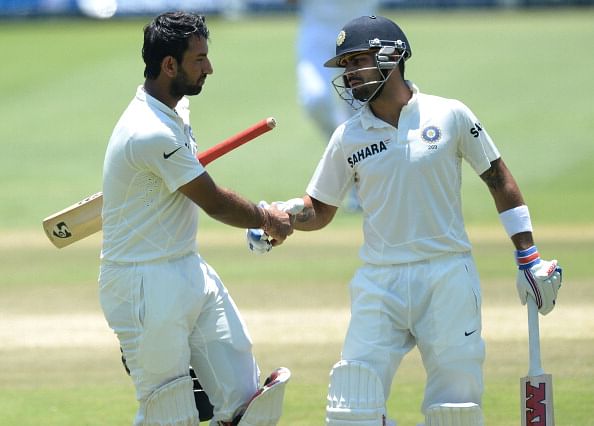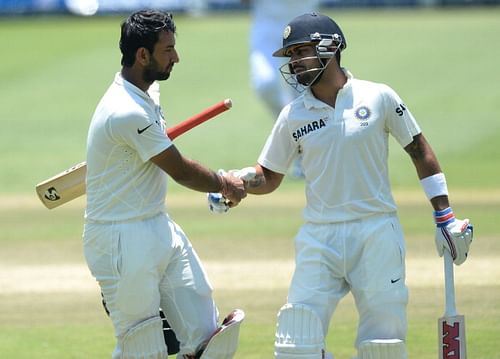
England v India 2014: With bowlers in question, Indian batsmen need to take charge

The striking common feature in both the Indian practice matches in England – against Leicestershire and Derbyshire - is that the Indian bowlers have been unable to take more than 5 wickets in any of the three innings they have bowled in, and this despite giving a go to all their 6 pace bowlers and the pace bowling all-rounder Stuart Binny, an unusually large number to carry around even considering that they are a touring team.
Leaving Ishant Sharma aside, the entire pace battery has played a total of 13 Test matches in their combined careers; Ishwar Pandey, Pankaj Singh and Stuart Binny are yet to open their account.
Mohammed Shami is probably one of India’s finest fast bowling prospects ever, and he has a potential to have a long and fruitful international career: pace, check; swing, check; bounce, check; heart to bowler longer spells, check. At 24, is he ready for this tour, though?
Bhuvneshwar Kumar seems to have found a new lease of life, at least it appeared so in the Indian Premier League 2014, after threatening to go the traditional Indian seamer’s way following a good couple of seasons. He hasn’t done much in his Test career, yet: 9 wickets in 6 Tests at 37.88. It remains to be seen if he has taken his IPL form with him to Old Blighty.
Pankaj Singh has been a wicket-taking machine in the Indian domestic circuit – 300 wickets in 77 first-class games at an average of 25.52 – and so is Ishwar Pandey: 161 wickets in 31 matches at an average of 24.42. At different phases of their career, do they have it in them to make an impact in the Test arena? In particular, at 29, has Pankaj Singh’s best gone past him? Have the selectors erred in getting him into the set-up too late?
Stuart Binny and Ravindra Jadeja have divided the nation into two feuding communities, but, even at best, they could only do a supporting role.
Varun Aaron can generate pace, but wickets, more so against better players of fast bowling? We will see.
We can be hopeful, but can we really place our expectations high on a bowling attack that got nowhere close to getting 20 wickets against a county side?
Ishant Sharma has flattered to deceive, as simple as that. The only reason why he is getting selected again and again is that India hardly has better options and for the occasional match-winning spells he is capable of producing. Even in India’s last overseas assignment – against New Zealand – he looked threatening, but, as soon the opposition took the game to him, he stopped making inroads.
An average of 37.56 in 55 Test matches sums it up.
Not much for the spinners:
In England, spinners have never been able to run the game. Ravindra Jadeja and Ravichandran Ashwin are, without a shadow of a doubt, good spinners with potential to become even better with age, as all spinners do, but let’s talk present, shall we?
Murali Karthik, despite being ignored from the Indian team, managed to attain a stature for himself before calling it a day recently, mainly due to his exploits on tough wickets with English county sides. He had an interesting point to add:
“You need to be big-hearted to bowl in England. It always boils down to your skill and your heart. That is the lesson I learned in my eight years of county cricket, where I played for four different teams.
India will know that since England don't have a specialist spinner anymore - after Graeme Swann's retirement and the disciplinary issues Monty Panesar is struggling with - it's highly unlikely that they will prepare pitches that will spin big even on the fourth day.”
England will never prepare spinning pitches. It is not their strength. So, they pretty much curtail the spin advantage that India otherwise had.
Indian pacers, as we discussed earlier, don’t generate much hope, either.
Under Pressure MS Dhoni:
Despite N Srinivasan’s backing, it is very hard to imagine MS Dhoni sticking to the captaincy post if he loses yet another overseas series. It has been nearly 3 years since India won a series abroad, and, if the trend continues, it will be his 5th consecutive series defeat on foreign soil.
Therefore, Indian batsmen have to step up to save their captain’s face.
The last time India toured England, their highest score in 4 matches was 300, thanks to a superhuman effort from Rahul Dravid. It was the abject failure of the Indian batsmen that led to the bowlers becoming even more inept.
Cheteshwar Pujara and Virat Kohli – the trump cards:
This time around, though, the batting, despite being devoid of great names, looks more in-form, which matters more. The team has more or less passed the transition phase. Despite the inexperience in terms of matches played, Virat Kohli and Cheteshwar Pujara are amongst the best Test batsmen in the world today. Kohli now has a Test century in each of the overseas nation he has toured - Australia, South Africa and New Zealand - to reassure the cricketing world that he is by no means limited to heroics in just the shorter formats.
Pujara has been the most dependable batsman India has got after Rahul Dravid retired: ready to do the hard yards and make opposition bowlers toil.
With Gautam Gambhir returning and the likes of Shikhar Dhawan, Ajinkya Rahane, Rohit Sharma and Dhoni himself, Indian batting looks potent enough to better their efforts last time, more so when the English wickets are not expected to have as much venom as they usually do.
Putting totals on the board in the range of 400-450 will ease the pressure of the bowlers and in turn lead to a better overall performance. Let us hope it happens!